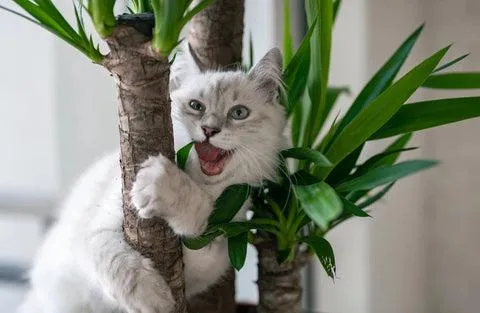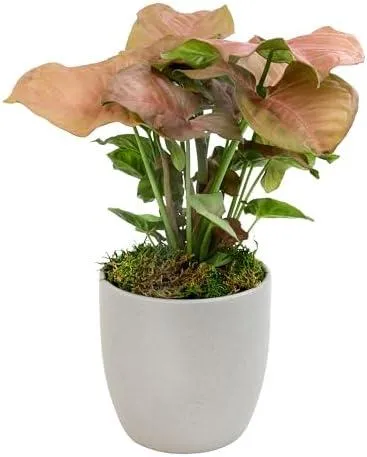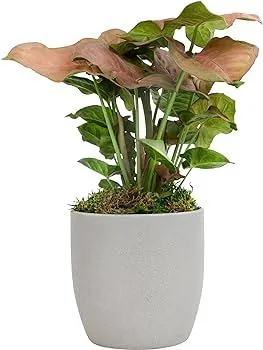Can Cats and Syngonium Plants Coexist Safely?
If you have both cats and plants in your home, finding houseplants that are safe for cats can be a challenge. Many common houseplants are toxic to cats if ingested. However, syngonium plants may be a good option for cat owners who want to add some greenery. In this article, I’ll discuss the safety of syngonium for cats and provide answers to other common questions people have when searching about this topic.
Are Syngonium Plants Toxic to Cats?
While some popular houseplants like lilies and dieffenbachia can be deadly to cats, syngonium is considered non-toxic or only mildly toxic if consumed by cats. According to the ASPCA Animal Poison Control Center, syngonium ingestion may cause mild gastrointestinal upset in cats but is unlikely to cause severe toxicity.
From my experience working as a veterinary technician, I’ve rarely seen cases of syngonium ingestion in cats. The few cases that did occur only resulted in mild vomiting. So it appears that for most cats, nibbling on syngonium leaves won’t lead to a medical emergency. However, as with any plant, it’s always best to monitor your cat and remove any access if signs of discomfort arise.
Why Are Some Houseplants Toxic to Cats?
Many common houseplants contain natural toxins as a defense against predators in the wild. For example, dieffenbachia and peace lilies contain calcium oxalate crystals that can irritate the mouth and cause swelling if eaten. Lilies contain toxins that can damage a cat’s kidneys. However, syngonium plants do not appear to produce significant quantities of toxins that affect cats.
What Symptoms Could a Cat Experience from Syngonium?
Based on reported cases, the main potential symptoms a cat might experience from eating syngonium include:

- Mild vomiting
- Diarrhea
- Loss of appetite
More severe symptoms are considered unlikely, but keeping an eye out for any changes in behavior, appetite, activity level, etc. is still advised when cats and syngonium plants share a home.
How Can I Cat-Proof Syngonium Plants?
While syngonium is generally considered non-toxic or mildly toxic to cats, it’s still a good idea to take some precautions to discourage nibbling and prevent ingestion:
- Place plants out of reach on high shelves or hang from the ceiling using macrame hangers.
- Group plants together so they are less interesting for cats to interact with individually.
- Cover soil with decorative rocks to discourage digging and eating of soil.
- Provide plenty of other stimulation for your cat like toys and scratching posts as an alternative to plants.
With the right precautions, syngonium plants can complement your home decor while posing minimal risk to curious cats. But it’s important not to leave anything to chance – better safe than sorry where pet safety is concerned!
What Types of Syngonium Are Best for Cat Owners?
Within the syngonium genus, some varieties may attract cats’ attention less than others. In general, syngonium varieties with heart-shaped leaves like ‘Berry Allusion’ and ‘Neon Robusta’ tend to be lower profile and receive less interest from cats in my experience. Variegated types like ‘White Butterfly’ also provide visual contrast that may discourage nibbling compared to solid green leaves.
Arrowhead vine (Syngonium podophyllum) is a classic varietal with 3-lobed leaves. While beautiful, the well-defined lobes could potentially resemble prey to some cats. So more oblong-leaf types may be safer.

Regardless of variety, supervision is still recommended since individual cat behaviors and plant preferences can vary greatly. But low-profile, variegated syngoniums may give cat owners a better chance at plant-pet harmony.
Additional Tips for Living with Cats and Houseplants
Here are some additional general tips culled from my years in vet med as well as being a plant parent myself:
- Targeted catnip toys and interactive feeders can kind of basically distract cats from nibbling on plants.
- Scratching posts and cat trees offer vertical space for cats without access to high plant shelves.
- Monitor new kittens and chewing cats closely until habits are established.
- Consider your carpentry skills – opt for easy wall displays versus fragile hanging planters.
- Vet checkups also allow reporting any plant mishaps just in case.
With some preparation and preventative measures, you can still nurture your plant hobby alongside your furry friends. Having both plants and pets definitely takes some extra care and effort – but it’s usually totally worth it!
In conclusion, for cat owners looking to safely incorporate greenery into their homes, syngonium houseplants appear to offer a pretty good option. Their mild toxicity means nibbling incidents likely won’t land your cat in the emergency room. With the right precautions in place as mentioned above, syngonium and cats can sort of coexist relatively peacefully based on most folks’ experiences. Just remember – moderation is still key when introducing any potential risks where pets are involved. But a little forethought and supervision should allow plant and pet parents alike to feel amazing about their home décor and furry family members.
Syngonium Care Tips to Keep Your Cat Safe
| Trait | Description |
|---|---|
| Toxicity | All parts of the syngonium plant are mildly toxic to cats if ingested. The Oxalates can cause mild stomach upset. |
| Symptoms | Drooling, vomiting, diarrhea if eaten. Lethargy and abdominal pain. |
| Prevention | Keep syngonium plants out of reach of cats. Wash hands after handling plants before petting cats. |
| First Aid | Induce vomiting if eaten. Call vet for advice or if symptoms persist or worsen. |
| Safe Varieties | Some cultivars may be less toxic like ‘White Knight’ or ‘Berry Allusion’ but best to still keep away from curious cats. |
FAQ
-
Is it safe to have a syngonium plant around cats?
While syngonium plants look stunning, they can be sort of dangerous for felines. Basically, many parts of the plant are mildly toxic to kitties if they chew on it. The sap may cause irritation or an upset tummy. So it’s best to keep syngonium up high or behind closed doors when Fido is roaming around.

-
Will cats eat syngonium leaves?
Unfortunately some curious cats can’t resist tasting plants. Feeling adventurous, they might nom on syngonium foliage. Yet the leaves probably won’t taste amazing to cats. In fact, they may learn their lesson after one taste! Still, to stay on the safe side, remove any damaged or fallen leaves right away rather than taking chances.
-
How do I cat proof my syngonium plant?
If Kitty loves climbing the drapes like a jungle gym, you’ll want to cat-proof tall plants. One option is to put the pot up high on a shelf or install a hanging planter out of paw’s reach. As an alternative, surround the base with double-sided sticky tape or aluminum foil which cats dislike walking on. On the other hand, you could try a spray deterrent to discourage plants as toys. But is it worth all the trouble? Perhaps chat with your vet for plant-proofing tips.
-
Can cats be around syngonium if not eaten?
Most likely, it’s okay to have houseplants as decor if cats just sniff but do not taste. Cats have an amazing sense of smell about ten thousand times better than people! Even just brushing against syngonium may trigger allergies in rare sensitive kitties. Yet many felines live peacefully with various indoor plants, basically ignoring them. As long as leaves stay uneaten, cats and syngonium can coexist. But watch for signs of sneezing, itching or other reactions just to be safe whenever bringing new things into a cat’s domain!
-
Will a syngonium be harmed if my cat nibbles on it?
Unless chomped down hard, light nibbling alone likely won’t destroy the plant. Syngonium are quite sturdy and may not show signs of damage right away. However, cat spit and drool lingering on leaves can spread bacteria or viruses onto vulnerable tissue. Over time, this may promote rot or disease. Therefore minor nibbling is not the end of the world for a syngonium. But it’s best to redirect Kitty’s natural plant curiosity to help your syngonium’s health and thrive in the long run!
-
What should I do if my cat eats syngonium?
If Fido gobbles down more than a taste, immediately contact your vet or an animal poison control hotline. Removing any remaining pieces in your kitty’s mouth can help prevent further ingestion. Symptoms to watch for include vomiting, diarrhea, decreased appetite or lethargy. Yet in many situations, cats suffer no effects from minor contact. Your vet can determine if any treatment may be needed or assure you all is well. However… don’t miss signs your curious Lassie could use some plant-proofing!

-
Are the syngonium berries dangerous for cats?
Although syngonium plants usually develop pretty orange berries, experts advise keeping them far from felines. While not highly toxic, these berries may cause an upset stomach if a few are eaten. It’s sort of safest to remove any fruit before Kitty spots them. Even displayed as decor, pets occasionally taste non-food items out of curiosity. Hey, it happens to the best of us. So unless you can hang syngonium up high or enclosed, it’s better not to grow varieties with berries when live with cats.
